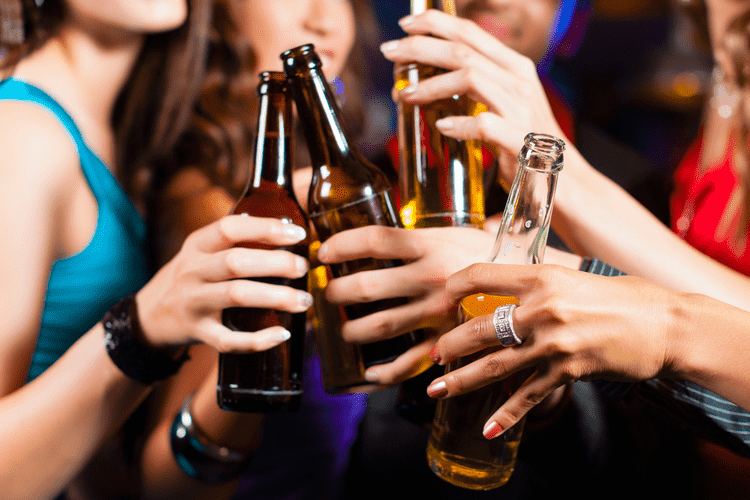In the short term, drinking alcohol can cause dry skin, flushing, dark circles, and decreased elasticity. Although drinking alcohol can cause a person to fall asleep faster, it may cause them to wake up more often during the night. All of these skin conditions may occur without any history of alcohol abuse.
For example, heavy alcohol consumption can cause generalized suppression of blood cell production and the production of structurally abnormal blood cell precursors that cannot mature into functional cells. Alcoholics frequently have defective red blood cells that are destroyed prematurely, possibly resulting in anemia. Alcohol also interferes with the production and function of white blood cells, especially those that defend the body against invading bacteria.
Nutritional deficiency
Even tiny amounts of alcohol may induce urticaria in people who have had a severe reaction previously, although allergy testing is often negative. Heavy drinking reduces options for treatment of psoriasis, as some medicines are contraindicated if the drinking has led to liver disease (methotrexate) http://electric-alipapa.ru/infusions/shoutbox_panel/shoutbox_archive.php?rowstart=740 or to high levels of triglyceride (acitretin). Patients with psoriasis and high alcohol intake are also more likely to suffer from depression. If you’re experiencing alcohol symptoms like easy bruising, or you simply want to break free from alcohol misuse, Confidant is here to help.

While drinking alcohol, our blood becomes thinner and the walls of our veins can also become thinner. If you develop unexplained bruising on your arms or legs, something caused it — you touched or bumped against something that resulted in that bruise. One common side effect of aging is an increase in skin bruising, and this can leave caregivers unsure of how to proceed. The line between “normal aging” and “make an appointment with. According to the Mayo Clinic, skin becomes thinner with age, resulting in a smaller barrier between skin and the blood vessels.
Skin changes due to alcoholic liver disease
For an accurate diagnosis, the physician must therefore exclude folic acid deficiency and evaluate the patient’s iron stores in the bone marrow. The direct consequences of excessive alcohol consumption include toxic effects on the bone marrow; the blood cell precursors; and the mature red blood cells (RBC’s), white blood cells (WBC’s), and platelets. Alcohol’s indirect effects include nutritional deficiencies that impair the production and function of various blood cells. Hemolysis can be an underlying cause of anemia, and several types of hemolytic anemia may be caused by chronic heavy alcohol consumption. Diagnosing hemolysis in alcoholic patients is not easy, because these patients frequently exhibit confounding conditions, such as alcohol withdrawal, abnormal folic acid levels, bleeding, or an enlarged spleen. AC is an enzyme that plays a role in the transmission of signals from a cell’s exterior to its interior; the enzyme’s levels in the body are genetically determined.
Numerous clinical observations support the notion that alcohol adversely affects the production and function of virtually all types of blood cells. Thus, alcohol is directly toxic to the bone marrow, which contains the precursors of all blood cells, as well as to the mature cells circulating in the bloodstream. Moreover, long-term excessive alcohol consumption can interfere with various physiological, biochemical, and metabolic processes involving the blood cells. The medical consequences of these adverse effects can be severe. These direct effects may be exacerbated by the presence of other alcohol-related disorders, such as liver disease and nutritional deficiencies.
Withdrawal Symptoms
Take medications to thin blood or stop clotting, such as aspirin or blood thinners. Regularly take nonsteroidal anti-inflammatory drugs (NSAIDs) for pain relief, including ibuprofen (Advil®) or naproxen (Aleve®). The liver makes proteins that the blood needs for clotting, so if it’s not doing its job, you may bleed or bruise more easily. It could be a sign that you’ve got a condition called cirrhosis, which is scarring of the liver.
- Finally, one potentially serious cause of alcohol and bruising is alcohol liver disease.
- In a case-control study of 175 people with rosacea and 145 people with normal skin, there was no significant difference in alcohol consumption between the two groups.
- The metabolism of bilirubin is impaired in acute and chronic liver disease.
- Apply ice immediately after the injury to reduce blood flow around the area.
Also known as nummular dermatitis, discoid eczema occurs more often in people who misuse alcohol, especially if they have liver problems. Alcohol consumption is the most common cause of porphyria cutanea http://karaokeplus.ru/?paged=2&tag=songs tarda (PCT). This condition causes painful, blistering lesions on the skin following exposure to the sun. Changes to the skin can be more serious and last longer if a person regularly consumes alcohol.
One component of RBC’s is hemoglobin, an iron-containing substance that is essential for oxygen transport. Sometimes, however, the iron is not incorporated properly into the hemoglobin molecules. Instead, it is converted into a storage http://www.chelpsy.ru/articles/vozrastanie-roli-innovatsionnoi-psikhologicheskoi-sluzhby-sanatorno-kurortnykh-uchrezhdenii form called ferritin, which can accumulate in RBC precursors, often forming granules that encircle the cell’s nucleus. These ferritin-containing cells, which are called ringed sideroblasts, cannot mature further into functional RBC’s.


